How Indira Gandhi's greed looted Rajput Royals during the emergency days 🧵
History is a great teacher to those who want to learn!!
Today Rajaputs of certain parts are raising the crescendo of dethroning Modi Ji by portraying him as anti-Rajput prime minister, so let's see how Congress treated Rajaputs during emergency!!
History is a great teacher to those who want to learn!!
Today Rajaputs of certain parts are raising the crescendo of dethroning Modi Ji by portraying him as anti-Rajput prime minister, so let's see how Congress treated Rajaputs during emergency!!
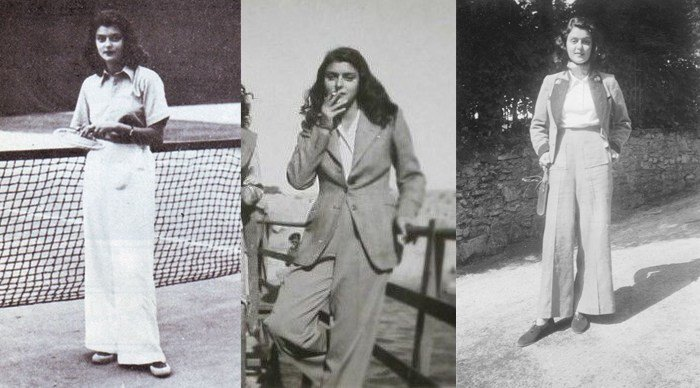
1. The Love story of Royal Lineage
Indira Devi of Baroda was considered one of the most beautiful women of her time. Born to Sayaji Rao Gaekwad III and his second wife Maharani Chimnabai in 1892, Indira Devi was a prize catch for any of India’s eligible royal bachelors.
Her parents agreed to an alliance with the State of Gwalior – one of India’s premiere royal households – with a 21-gun-salute, the ultimate act of acknowledgement from the British Empire. In 1911, however, when the 18-year-old Indira Devi was attending the Delhi Durbar, she fell head-over-Ferragamo-heels for Prince Jitendra of Cooch Behar. The younger brother of the Maharaja of Cooch Behar, Jitendra was a far cry from the Maharaja of Gwalior, Madho Rao Scindia.
Taking matters into her own hands, Indira then committed the gravest breech of royal protocol when she wrote a letter to Madho Rao Scinida, professing her love for Jitendra and requesting the Maharaja to dissolve their engagement.
Perturbed by their daughter’s brazen flaunting of rules and etiquette, the Maharaja of Baroda tried everything he could, even calling the Prince for a scolding, but to no avail. The couple were ultimately allowed to marry in London, without any member of their family in attendance.
This, only after the Maharaja of Baroda had received a letter from Madho Rao Scindia stating that he understood the situation and would not hold it against the Baroda family.
Once married, Indira Devi and Jitendra moved to Cooch Behar where, within a few months of the wedding, the Maharaja of Cooch Behar passed away, making Jitendra the ruler of the State and elevating Indira Devi to the position of Maharani.
The couple famously sired Gayatri Devi, who would go on to marry the Maharaja of Jaipur, and later become a force in her own right.

Indira Devi of Baroda was considered one of the most beautiful women of her time. Born to Sayaji Rao Gaekwad III and his second wife Maharani Chimnabai in 1892, Indira Devi was a prize catch for any of India’s eligible royal bachelors.
Her parents agreed to an alliance with the State of Gwalior – one of India’s premiere royal households – with a 21-gun-salute, the ultimate act of acknowledgement from the British Empire. In 1911, however, when the 18-year-old Indira Devi was attending the Delhi Durbar, she fell head-over-Ferragamo-heels for Prince Jitendra of Cooch Behar. The younger brother of the Maharaja of Cooch Behar, Jitendra was a far cry from the Maharaja of Gwalior, Madho Rao Scindia.
Taking matters into her own hands, Indira then committed the gravest breech of royal protocol when she wrote a letter to Madho Rao Scinida, professing her love for Jitendra and requesting the Maharaja to dissolve their engagement.
Perturbed by their daughter’s brazen flaunting of rules and etiquette, the Maharaja of Baroda tried everything he could, even calling the Prince for a scolding, but to no avail. The couple were ultimately allowed to marry in London, without any member of their family in attendance.
This, only after the Maharaja of Baroda had received a letter from Madho Rao Scindia stating that he understood the situation and would not hold it against the Baroda family.
Once married, Indira Devi and Jitendra moved to Cooch Behar where, within a few months of the wedding, the Maharaja of Cooch Behar passed away, making Jitendra the ruler of the State and elevating Indira Devi to the position of Maharani.
The couple famously sired Gayatri Devi, who would go on to marry the Maharaja of Jaipur, and later become a force in her own right.


2. The marriage
In 1940 marriage of Maharani Gayatri Devi (Then Princess of Cooch Bihar Ayesha) was solemnized with Maharaja of Jaipur Sawai Man Singh II. Thus, begun the chapter of history which would be unique and full of intrigue.
In 1940 marriage of Maharani Gayatri Devi (Then Princess of Cooch Bihar Ayesha) was solemnized with Maharaja of Jaipur Sawai Man Singh II. Thus, begun the chapter of history which would be unique and full of intrigue.

3. The Cosmopolitan Maharani
Maharani Gayatri Devi was an intelligent fashionable and compassionate persona with a free-spirited panache for the life. But she was a people's princess and people of Jaipur reciprocated her love for them in no equal measures!!



Maharani Gayatri Devi was an intelligent fashionable and compassionate persona with a free-spirited panache for the life. But she was a people's princess and people of Jaipur reciprocated her love for them in no equal measures!!
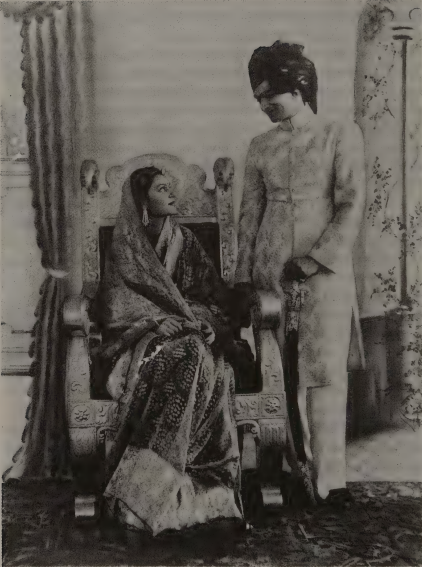



4. The Dutiful Maharani
Maharani Gayatri Devi was as much a socialite as much she was a dutiful wife and riyal princess.


Maharani Gayatri Devi was as much a socialite as much she was a dutiful wife and riyal princess.


5. The Icon
Maharani Gayatri Devi was a particularly avid equestrienne. She was an excellent rider and an able Polo player. She was a good shooting and enjoyed many days out on 'Shikars'. She was fond of cars and is credited with importing the first Mercedes-Benz W126, a 500 SEL to India which was later shipped to Malaysia. She also owned several Rolls-Royces and an aircraft.



Maharani Gayatri Devi was a particularly avid equestrienne. She was an excellent rider and an able Polo player. She was a good shooting and enjoyed many days out on 'Shikars'. She was fond of cars and is credited with importing the first Mercedes-Benz W126, a 500 SEL to India which was later shipped to Malaysia. She also owned several Rolls-Royces and an aircraft.



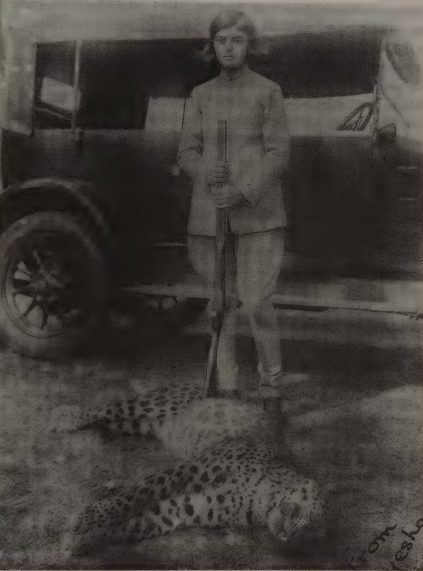
6. The Politics of Swatantra Party
The Swatantra Party was an Indian classical liberal political party that existed from 1959 to 1974. It was founded by C. Rajagopalachari in reaction to what he felt was the Jawaharlal Nehru-dominated Indian National Congress's increasingly socialist and statist outlook.
Swatantra Party stood for a market-based economy and the dismantling of the "Licence Raj" although it opposed laissez-faire policies. Considered to be on the economic right of the Indian political spectrum, Swatantra was a liberal outlook party, unlike the Hindu nationalism of the Bharatiya Jana Sangh.
In 1960, Rajagopalachari and his colleagues drafted a 21-point manifesto detailing why Swatantra had to be formed even though they had been Congressmen and associates of Nehru during the struggle for independence. Prime Minister Jawaharlal Nehru was highly critical of Swatantra and dubbed it as belonging to "the middle ages of lords, castles and zamindars".
In the 1962 general election, the first after its formation, Swatantra received 7.89 percent of the total votes and won 18 seats in the third Lok Sabha (1962–67). It emerged as the main opposition to the dominant Congress in four states: Bihar, Rajasthan, Gujarat and Orissa. By the next general election in 1967, Swatantra had become a significant force in some parts of India; it won 8.7 percent of the votes and became the single-largest opposition party in the fourth Lok Sabha (1967–71) with 44 seats. In 1971, Swatantra joined a "Grand Alliance" of parties from across the political spectrum that aimed to defeat Prime Minister Indira Gandhi. The party secured eight seats by winning 3% of the votes. The next year, in 1972, its founder, Rajagopalachari, died, and Swatantra declined rapidly. By 1974, it had dissolved, with many of its members joining the Charan Singh-led Bharatiya Lok Dal.


The Swatantra Party was an Indian classical liberal political party that existed from 1959 to 1974. It was founded by C. Rajagopalachari in reaction to what he felt was the Jawaharlal Nehru-dominated Indian National Congress's increasingly socialist and statist outlook.
Swatantra Party stood for a market-based economy and the dismantling of the "Licence Raj" although it opposed laissez-faire policies. Considered to be on the economic right of the Indian political spectrum, Swatantra was a liberal outlook party, unlike the Hindu nationalism of the Bharatiya Jana Sangh.
In 1960, Rajagopalachari and his colleagues drafted a 21-point manifesto detailing why Swatantra had to be formed even though they had been Congressmen and associates of Nehru during the struggle for independence. Prime Minister Jawaharlal Nehru was highly critical of Swatantra and dubbed it as belonging to "the middle ages of lords, castles and zamindars".
In the 1962 general election, the first after its formation, Swatantra received 7.89 percent of the total votes and won 18 seats in the third Lok Sabha (1962–67). It emerged as the main opposition to the dominant Congress in four states: Bihar, Rajasthan, Gujarat and Orissa. By the next general election in 1967, Swatantra had become a significant force in some parts of India; it won 8.7 percent of the votes and became the single-largest opposition party in the fourth Lok Sabha (1967–71) with 44 seats. In 1971, Swatantra joined a "Grand Alliance" of parties from across the political spectrum that aimed to defeat Prime Minister Indira Gandhi. The party secured eight seats by winning 3% of the votes. The next year, in 1972, its founder, Rajagopalachari, died, and Swatantra declined rapidly. By 1974, it had dissolved, with many of its members joining the Charan Singh-led Bharatiya Lok Dal.
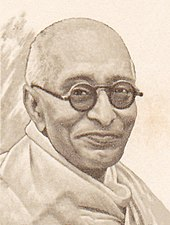


7. Maharani the Politician
Maharani Gayatri Devi ran for Parliament in 1962 and won the constituency in the Lok Sabha in the world's largest landslide, winning 192,909 votes out of 246,516 cast. She continued to hold this seat in 1967 and 1971 as a member of the Swatantra Party founded by C. Rajagopalachari, running against the Indian National Congress.
In 1965, during a meeting with Prime Minister Lal Bahadur Shastri, Maharani Gayatri was again asked to join Congress. Despite the fact that her husband was being made ambassador to Spain, she stuck to her principles and decided not to join the party. In 1967 the Swatantra party joined hands with Jan Sangh that was led by Bhairon Singh Shekhawat. The alliance won a large number of seats in the 1967 election. In the assembly election Gayatri lost to Damodar Lal Vyas, in Malpura constituency, but won the Lok Sabha election.
Her persona, her charisma and political apposition were a direct challenge to Indira Gandhi who despised her like anything in private. Indira Gandhi was looking for a chance to decimate the royal apposition to her political throne.


Maharani Gayatri Devi ran for Parliament in 1962 and won the constituency in the Lok Sabha in the world's largest landslide, winning 192,909 votes out of 246,516 cast. She continued to hold this seat in 1967 and 1971 as a member of the Swatantra Party founded by C. Rajagopalachari, running against the Indian National Congress.
In 1965, during a meeting with Prime Minister Lal Bahadur Shastri, Maharani Gayatri was again asked to join Congress. Despite the fact that her husband was being made ambassador to Spain, she stuck to her principles and decided not to join the party. In 1967 the Swatantra party joined hands with Jan Sangh that was led by Bhairon Singh Shekhawat. The alliance won a large number of seats in the 1967 election. In the assembly election Gayatri lost to Damodar Lal Vyas, in Malpura constituency, but won the Lok Sabha election.
Her persona, her charisma and political apposition were a direct challenge to Indira Gandhi who despised her like anything in private. Indira Gandhi was looking for a chance to decimate the royal apposition to her political throne.



8. The Privy purse
At the time of the independence in 1947 there were more than 500 princely states in India and covered 48% area of pre-independent India and constituted 28% of its population.
As defined from 1949 under Article 291 of the Indian Constitution, a privy purse would be a fixed, tax-free sum guaranteed to the former princely rulers and their successors. The sum was intended to cover all expenses of the former ruling families, including those incurred for religious and other ceremonies, and would be charged on the Consolidated Fund of India. With India remaining a member of the sterling area post-independence, and with the Indian rupee remaining pegged to the British pound sterling, the privy-purse payments constituted a significant outlay of government funds.
By the eve of independence, most of the princely states had signed instruments of accession to India, and only one to Pakistan.
The instruments of accession needed the states to only cede defence, communications and foreign relations to India. Democratic institutions were introduced in these states, and it was only in 1949 that they were fully merged with India to form new states. Thus, Travancore, and Cochin merged into India and formed the new state of Thiru-Kochi.
Although the royal families had been allowed to retain large sums of money as their privy purse in 1947, in 1949, with the states and its revenues being entirely taken over by the Government of India, it was the Indian Government that provided the rulers and their families with privy purses that were determined by several factors such as the state's revenue, whether the state had been ranked as a salute state under the British Raj or not, antiquity of the dynasty, and so on.
The privy purses were determined by several factors. Minor feudatories of the erstwhile princely states received whatever little allowances the princely governments had been providing them. For the 565 princely states, privy purses ranged from ₹5,000 per annum to amounts in millions. About 102 privy purses were of more than a ₹100,000 with an upper ceiling of ₹200,000 for all except 11 states.
Only eleven of the most important princely states in India were provided with privy purses of ₹1,000,000 and above (worth 8,898 oz of gold): Hyderabad, Mysore, Travancore, Baroda, Jaipur, Patiala, Nawanagar, Bhavnagar State, Rewa district, Bhopal and Kolhapur. While certain amounts were guaranteed for the time being, it was liable to be reduced soon after due to deflation crisis in 1960s.
Thus, Hyderabad, which received initially a privy purse of ₹4,285,714, was, a few years later, guaranteed ₹2,000,000 purse. Other titular rulers of princely states, such as those of the Royal House of Rampur, among others, received a privy purse as well. The Government of India also, generally, reduced the allowances with every succession in the family.
A motion to abolish the privy purses, and the official recognition of the titles, was originally brought before the Parliament in 1970 and passed in the Lok Sabha, but failed by one vote to reach the required two-thirds majority in the Rajya Sabha, with 149 voting for and 75 against.
On 6 September 1970, the President of India passed an laconic order in respect of each of the rulers of former Indian states. In exercise of the power vested in him under Article 366 of the constitution, the President directed that with effect from the date of his order, all rulers ceased to be recognized as rulers. That resulted in the immediate termination of the privy purses received by the rulers, and the discontinuance of their personal privileges. Writ petitions under Article 32 of the constitution were filed by some of the rulers as test cases to question the orders. The Supreme Court ruled in favour of the rulers.
It was again proposed before Parliament in 1971, and was successfully passed as the 26th Amendment to the Constitution of India in 1971. It became Article 363 A of Indian constitution.

At the time of the independence in 1947 there were more than 500 princely states in India and covered 48% area of pre-independent India and constituted 28% of its population.
As defined from 1949 under Article 291 of the Indian Constitution, a privy purse would be a fixed, tax-free sum guaranteed to the former princely rulers and their successors. The sum was intended to cover all expenses of the former ruling families, including those incurred for religious and other ceremonies, and would be charged on the Consolidated Fund of India. With India remaining a member of the sterling area post-independence, and with the Indian rupee remaining pegged to the British pound sterling, the privy-purse payments constituted a significant outlay of government funds.
By the eve of independence, most of the princely states had signed instruments of accession to India, and only one to Pakistan.
The instruments of accession needed the states to only cede defence, communications and foreign relations to India. Democratic institutions were introduced in these states, and it was only in 1949 that they were fully merged with India to form new states. Thus, Travancore, and Cochin merged into India and formed the new state of Thiru-Kochi.
Although the royal families had been allowed to retain large sums of money as their privy purse in 1947, in 1949, with the states and its revenues being entirely taken over by the Government of India, it was the Indian Government that provided the rulers and their families with privy purses that were determined by several factors such as the state's revenue, whether the state had been ranked as a salute state under the British Raj or not, antiquity of the dynasty, and so on.
The privy purses were determined by several factors. Minor feudatories of the erstwhile princely states received whatever little allowances the princely governments had been providing them. For the 565 princely states, privy purses ranged from ₹5,000 per annum to amounts in millions. About 102 privy purses were of more than a ₹100,000 with an upper ceiling of ₹200,000 for all except 11 states.
Only eleven of the most important princely states in India were provided with privy purses of ₹1,000,000 and above (worth 8,898 oz of gold): Hyderabad, Mysore, Travancore, Baroda, Jaipur, Patiala, Nawanagar, Bhavnagar State, Rewa district, Bhopal and Kolhapur. While certain amounts were guaranteed for the time being, it was liable to be reduced soon after due to deflation crisis in 1960s.
Thus, Hyderabad, which received initially a privy purse of ₹4,285,714, was, a few years later, guaranteed ₹2,000,000 purse. Other titular rulers of princely states, such as those of the Royal House of Rampur, among others, received a privy purse as well. The Government of India also, generally, reduced the allowances with every succession in the family.
A motion to abolish the privy purses, and the official recognition of the titles, was originally brought before the Parliament in 1970 and passed in the Lok Sabha, but failed by one vote to reach the required two-thirds majority in the Rajya Sabha, with 149 voting for and 75 against.
On 6 September 1970, the President of India passed an laconic order in respect of each of the rulers of former Indian states. In exercise of the power vested in him under Article 366 of the constitution, the President directed that with effect from the date of his order, all rulers ceased to be recognized as rulers. That resulted in the immediate termination of the privy purses received by the rulers, and the discontinuance of their personal privileges. Writ petitions under Article 32 of the constitution were filed by some of the rulers as test cases to question the orders. The Supreme Court ruled in favour of the rulers.
It was again proposed before Parliament in 1971, and was successfully passed as the 26th Amendment to the Constitution of India in 1971. It became Article 363 A of Indian constitution.


9. The arrest
After 1971 Swantatra Pary fotunes were waning and it got dissolved. But hatred Indira Gandhi had for Charismatic Maharani of Jaipur never extinguished.
During the fateful days of emergency enforced by Indira Gandhi in 1975, Maharani was arrested under the COFEPOSA Act during the Emergency in July 1975 due to an alleged political vendetta on the accusation of violating tax laws.
After 1971 Swantatra Pary fotunes were waning and it got dissolved. But hatred Indira Gandhi had for Charismatic Maharani of Jaipur never extinguished.
During the fateful days of emergency enforced by Indira Gandhi in 1975, Maharani was arrested under the COFEPOSA Act during the Emergency in July 1975 due to an alleged political vendetta on the accusation of violating tax laws.

10. The search for the treasure
Indira Gandhi was of the opinion that in many Royal Palaces of Jaipur whether it is Moti Dungri or Jaigarh Palaces, Historical treasures are being hidden.
Now the government needed Just a way how to get there. Emergency became an excuse. These Palaces were also declared As national monuments During Emergency. Under this, these Palace will be directly under the Control of central government.
Then the Indira Gandhi sent Many Government Agencies including ED, Income tax Department team to Jaipur for Investigation. Queen Gayatri Exclaimed that “She does not know about any kind of treasure in Jaipur Palace”.
For Further Investigation Gayatri Devi was Arrested.

Indira Gandhi was of the opinion that in many Royal Palaces of Jaipur whether it is Moti Dungri or Jaigarh Palaces, Historical treasures are being hidden.
Now the government needed Just a way how to get there. Emergency became an excuse. These Palaces were also declared As national monuments During Emergency. Under this, these Palace will be directly under the Control of central government.
Then the Indira Gandhi sent Many Government Agencies including ED, Income tax Department team to Jaipur for Investigation. Queen Gayatri Exclaimed that “She does not know about any kind of treasure in Jaipur Palace”.
For Further Investigation Gayatri Devi was Arrested.


11. The Open Theft
Few days later an army Contingent was sent to Jaipur for excavation of Moti Dungri and Later Jaigarh Palace.Excavations started in the Palace of Jaipur, Amer,Jaigarh,Moti Dooangari.
After 4-5 months of excavation, a secret Telegraph of Message was sent to Government that the "search has been completed and the treasure has been found"!!
Sanjay Gandhi himself flew his own plane and reached Sanganer Airport Of Jaipur. Even though the Newspaper Agencies and Media house were Working Under Central Government during Emergency but Somehow the news of Treasure Spreads across country.


Few days later an army Contingent was sent to Jaipur for excavation of Moti Dungri and Later Jaigarh Palace.Excavations started in the Palace of Jaipur, Amer,Jaigarh,Moti Dooangari.
After 4-5 months of excavation, a secret Telegraph of Message was sent to Government that the "search has been completed and the treasure has been found"!!
Sanjay Gandhi himself flew his own plane and reached Sanganer Airport Of Jaipur. Even though the Newspaper Agencies and Media house were Working Under Central Government during Emergency but Somehow the news of Treasure Spreads across country.



12. The Loot
Seeing the Situation Curfew was imposed in Jaipur for Almost 1 Week and Army (Aircraft and vehicles) were called. The government claims to have found only a “few kilos of gold there”.
But the kind of situation created and the Way Jaipur-Delhi Highway was closed for 2 days and Tressure was sent in 6 army trucks to Delhi Under Sanjay Gandh's watch.
The government had alleged that it was Illegal Property. Actually, the question of illegal property does not even arise because when the first budget of Rajasthan government was presented, the bureau of all this treasury was given.
Maharani Gayatri Devi was kept in Tihar Jail, Delhi in most dilapidated conditions.



Seeing the Situation Curfew was imposed in Jaipur for Almost 1 Week and Army (Aircraft and vehicles) were called. The government claims to have found only a “few kilos of gold there”.
But the kind of situation created and the Way Jaipur-Delhi Highway was closed for 2 days and Tressure was sent in 6 army trucks to Delhi Under Sanjay Gandh's watch.
The government had alleged that it was Illegal Property. Actually, the question of illegal property does not even arise because when the first budget of Rajasthan government was presented, the bureau of all this treasury was given.
Maharani Gayatri Devi was kept in Tihar Jail, Delhi in most dilapidated conditions.




13. The Mystery and the aura
The royal treasure was straightaway ferried to the Palam Airport Delhi and hauled into a plane destined for an undisclosed location outside India!!
On 11th January 1976 Maharani Gayatri Devi was released from the Tihar Jail.
Post that Maharani Gayatri Devi resigned from the politics and got busy with the welfare of her subjects in her area of the erstwhile princely state of Jaipur.



The royal treasure was straightaway ferried to the Palam Airport Delhi and hauled into a plane destined for an undisclosed location outside India!!
On 11th January 1976 Maharani Gayatri Devi was released from the Tihar Jail.
Post that Maharani Gayatri Devi resigned from the politics and got busy with the welfare of her subjects in her area of the erstwhile princely state of Jaipur.


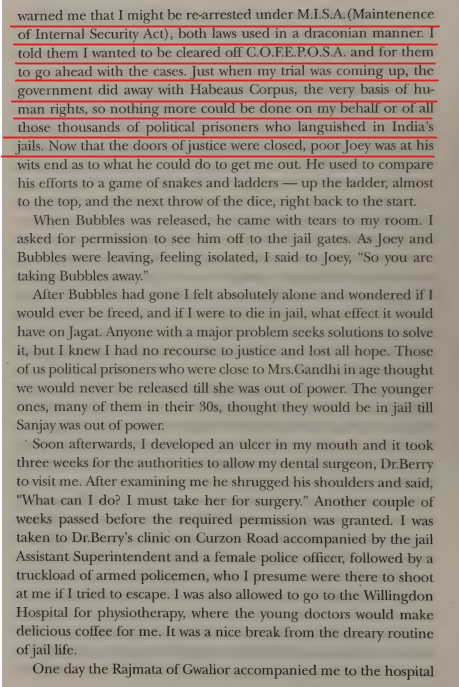

14. The icon who stood tall in the middle of ruins
This is one of the dark chapters of the emergency era which remains etched in the memories of the countless people who firsthand witnessed the draconian horrors of the emergency and dictatorship of Indira Gandhi.
Maharani Gayatri Devi remained the eternal symbol of grace, beauty, compassion and a fight for the just causes when entire country was reeling under the loot culture, license raj and politcla nepotism of Indira Gandhi and her son Sanjay Gandhi!!



This is one of the dark chapters of the emergency era which remains etched in the memories of the countless people who firsthand witnessed the draconian horrors of the emergency and dictatorship of Indira Gandhi.
Maharani Gayatri Devi remained the eternal symbol of grace, beauty, compassion and a fight for the just causes when entire country was reeling under the loot culture, license raj and politcla nepotism of Indira Gandhi and her son Sanjay Gandhi!!




15. Reference:
A princess remembers : the memoirs of the Maharani of Jaipur, Gayatri Devi
() dn790008.ca.archive.org/0/items/prince…

A princess remembers : the memoirs of the Maharani of Jaipur, Gayatri Devi
() dn790008.ca.archive.org/0/items/prince…

• • •
Missing some Tweet in this thread? You can try to
force a refresh
























